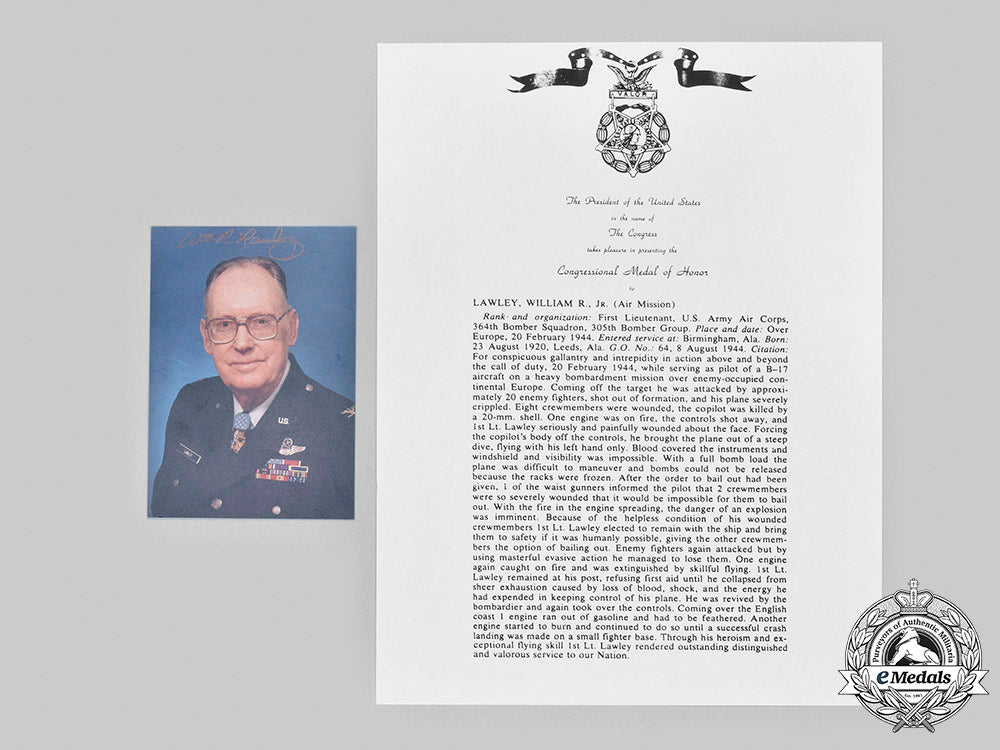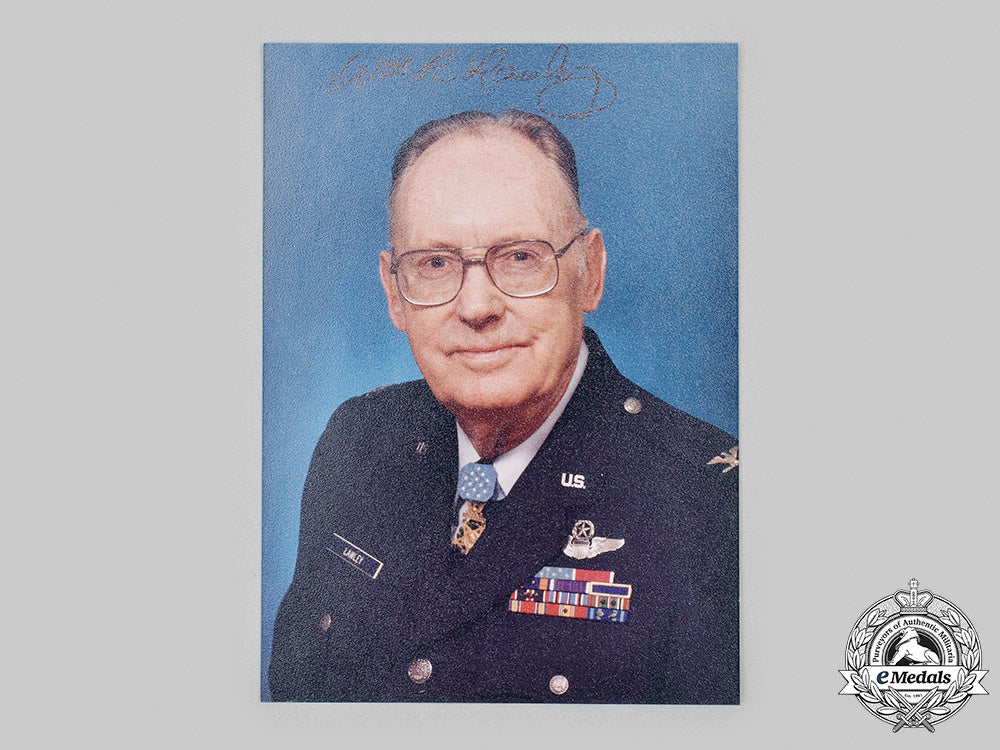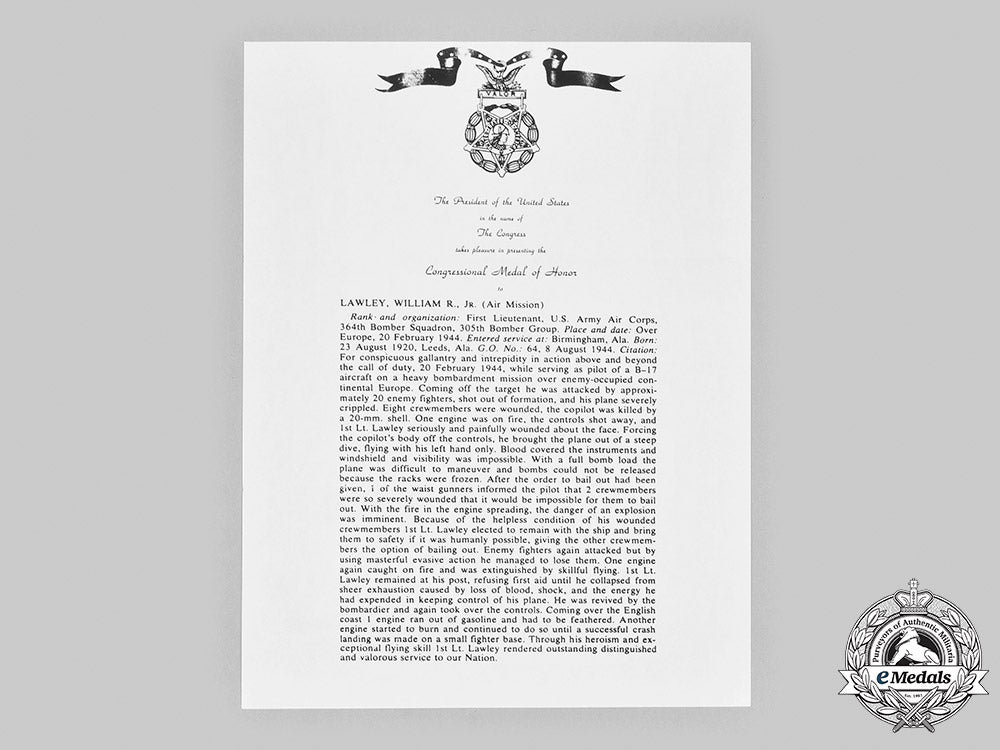
LOADING ...
In response to evolving domestic opinion, eMedals Inc has made the conscious decision to remove the presentation of German Third Reich historical artifacts from our online catalogue. For three decades, eMedals Inc has made an effort to preserve history in all its forms. As historians and researchers, we have managed sensitive articles and materials with the greatest of care and respect for their past and present social context. We acknowledge the growing sentiments put forth by the Canadian public and have taken proactive actions to address this opinion.




United States. A Signed Photograph Of Moh Recipient, February 20, 1944, 364Th Bombardment Squadron
United States. A Signed Photograph Of Moh Recipient, February 20, 1944, 364Th Bombardment Squadron
SKU: ITEM: W6705
0% Buyer's Premium
Current Bid:
Your Max Bid:
Bid History:
Time Remaining:
Couldn't load pickup availability
Shipping Details
Shipping Details
eMedals offers rapid domestic and international shipping. Orders received prior to 12:00pm (EST) will be shipped on the same business day.* Orders placed on Canadian Federal holidays will be dispatched the subsequent business day. Courier tracking numbers are provided for all shipments. All items purchased from eMedals can be returned for a full monetary refund or merchandise credit, providing the criteria presented in our Terms & Conditions are met. *Please note that the addition of a COA may impact dispatch time.
Shipping Details
eMedals offers rapid domestic and international shipping. Orders received prior to 12:00pm (EST) will be shipped on the same business day.* Orders placed on Canadian Federal holidays will be dispatched the subsequent business day. Courier tracking numbers are provided for all shipments. All items purchased from eMedals can be returned for a full monetary refund or merchandise credit, providing the criteria presented in our Terms & Conditions are met. *Please note that the addition of a COA may impact dispatch time.
Description
Description
In color, signed along the top edge "Wm R Lawley" on the obverse, measuring 88 mm (w) x 123 mm (h), extremely fine. Accompanied by a copy of his citation.
Footnote: William Robert Lawley Jr. was born on August 23, 1920 in Leeds, Jefferson County, Alabama and made his home in Birmingham, Jefferson County, Alabama. Lawley joined the Army Air Forces from Birmingham in April 1942, and by February 20, 1944 was a First Lieutenant serving as a pilot in the 364th Bombardment Squadron, 305th Bombardment Group (H), Eighth Air Force. On that day, during a bombing mission over Nazi-controlled Europe, his B-17 Flying Fortress came under attack by enemy fighter aircraft. With his plane severely damaged and on fire, he ordered his crew to parachute to safety. Finding that two crewmen were too badly injured to bail out, Lawley chose to remain in the aircraft and, despite his own serious wounds, attempt to pilot it into friendly territory. Although weakened from loss of blood and shock, he was able to make a successful crash landing in England. Lawley recovered from his wounds. His actions that day earned him a Congressional Medal of Honor from the War Department, General Orders No. 64, August 8, 1944. His citation states: "The President of the United States of America, in the name of Congress, takes pleasure in presenting the Medal of Honor to First Lieutenant (Air Corps) William Robert Lawley, Jr., United States Army Air Forces, for conspicuous gallantry and intrepidity in action above and beyond the call of duty, 20 February 1944, while serving as pilot of a B-17 aircraft in the 364th Bombardment Squadron, 305th Bombardment Group (H), Eighth Air Force, on a heavy bombardment mission over enemy-occupied continental Europe. Coming off the target he was attacked by approximately 20 enemy fighters, shot out of formation, and his plane severely crippled. Eight crew members were wounded, the copilot was killed by a 20-mm shell. One engine was on fire, the controls shot away, and First Lieutenant Lawley seriously and painfully wounded about the face. Forcing the copilot's body off the controls, he brought the plane out of a steep dive, flying with his left hand only. Blood covered the instruments and windshield and visibility was impossible. With a full bomb load the plane was difficult to maneuver and bombs could not be released because the racks were frozen.
After the order to bail out had been given, one of the waist gunners informed the pilot that two crew members were so severely wounded that it would be impossible for them to bail out. With the fire in the engine spreading, the danger of an explosion was imminent. Because of the helpless condition of his wounded crew members First Lieutenant Lawley elected to remain with the ship and bring them to safety if it was humanly possible, giving the other crew members the option of bailing out. Enemy fighters again attacked but by using masterful evasive action he managed to lose them. One engine again caught on fire and was extinguished by skillful flying. First Lieutenant Lawley remained at his post, refusing first aid until he collapsed from sheer exhaustion caused by loss of blood, shock, and the energy he had expended in keeping control of his plane. He was revived by the bombardier and again took over the controls. Coming over the English coast one engine ran out of gasoline and had to be feathered. Another engine started to burn and continued to do so until a successful crash landing was made on a small fighter base. Through his heroism and exceptional flying skill, First Lieutenant Lawley rendered outstanding distinguished and valorous service to our Nation." After earning the Congressional Medal of Honor, William Lawley transferred to the new United States Air Force when it became a separate branch of service in 1947, and retired in 1972 as a Colonel. He died on May 29, 1999 in Montgomery, Montgomery County, Alabama, at the age of 78 and is buried in Greenwood Cemetery in Montgomery, Plot: Section 12, Veterans' Field of Honor.
Description
In color, signed along the top edge "Wm R Lawley" on the obverse, measuring 88 mm (w) x 123 mm (h), extremely fine. Accompanied by a copy of his citation.
Footnote: William Robert Lawley Jr. was born on August 23, 1920 in Leeds, Jefferson County, Alabama and made his home in Birmingham, Jefferson County, Alabama. Lawley joined the Army Air Forces from Birmingham in April 1942, and by February 20, 1944 was a First Lieutenant serving as a pilot in the 364th Bombardment Squadron, 305th Bombardment Group (H), Eighth Air Force. On that day, during a bombing mission over Nazi-controlled Europe, his B-17 Flying Fortress came under attack by enemy fighter aircraft. With his plane severely damaged and on fire, he ordered his crew to parachute to safety. Finding that two crewmen were too badly injured to bail out, Lawley chose to remain in the aircraft and, despite his own serious wounds, attempt to pilot it into friendly territory. Although weakened from loss of blood and shock, he was able to make a successful crash landing in England. Lawley recovered from his wounds. His actions that day earned him a Congressional Medal of Honor from the War Department, General Orders No. 64, August 8, 1944. His citation states: "The President of the United States of America, in the name of Congress, takes pleasure in presenting the Medal of Honor to First Lieutenant (Air Corps) William Robert Lawley, Jr., United States Army Air Forces, for conspicuous gallantry and intrepidity in action above and beyond the call of duty, 20 February 1944, while serving as pilot of a B-17 aircraft in the 364th Bombardment Squadron, 305th Bombardment Group (H), Eighth Air Force, on a heavy bombardment mission over enemy-occupied continental Europe. Coming off the target he was attacked by approximately 20 enemy fighters, shot out of formation, and his plane severely crippled. Eight crew members were wounded, the copilot was killed by a 20-mm shell. One engine was on fire, the controls shot away, and First Lieutenant Lawley seriously and painfully wounded about the face. Forcing the copilot's body off the controls, he brought the plane out of a steep dive, flying with his left hand only. Blood covered the instruments and windshield and visibility was impossible. With a full bomb load the plane was difficult to maneuver and bombs could not be released because the racks were frozen.
After the order to bail out had been given, one of the waist gunners informed the pilot that two crew members were so severely wounded that it would be impossible for them to bail out. With the fire in the engine spreading, the danger of an explosion was imminent. Because of the helpless condition of his wounded crew members First Lieutenant Lawley elected to remain with the ship and bring them to safety if it was humanly possible, giving the other crew members the option of bailing out. Enemy fighters again attacked but by using masterful evasive action he managed to lose them. One engine again caught on fire and was extinguished by skillful flying. First Lieutenant Lawley remained at his post, refusing first aid until he collapsed from sheer exhaustion caused by loss of blood, shock, and the energy he had expended in keeping control of his plane. He was revived by the bombardier and again took over the controls. Coming over the English coast one engine ran out of gasoline and had to be feathered. Another engine started to burn and continued to do so until a successful crash landing was made on a small fighter base. Through his heroism and exceptional flying skill, First Lieutenant Lawley rendered outstanding distinguished and valorous service to our Nation." After earning the Congressional Medal of Honor, William Lawley transferred to the new United States Air Force when it became a separate branch of service in 1947, and retired in 1972 as a Colonel. He died on May 29, 1999 in Montgomery, Montgomery County, Alabama, at the age of 78 and is buried in Greenwood Cemetery in Montgomery, Plot: Section 12, Veterans' Field of Honor.




You May Also Like
Germany, Third Reich. A Mixed Lot of Tyrolean Marksmanship Badges
G52930
Germany, SS. An Estonian Waffen-SS Volunteer’s Sleeve Shield
G50381
Germany, SS. A Waffen-SS Sturmmann Sleeve Insignia
G52846
Germany, Third Reich; Slovakia, First Republic. A Mixed Lot of Wartime Postcards
G52905
Germany, Third Reich. A Pair of Tyrolean Marksmanship Badges
G52981
-
Germany, Third Reich. A Mixed Lot of Tyrolean Marksmanship Badges
G52930
Add to CartRegular price $135 USDRegular price $0 USD Sale price $135 USDUnit price / per -
Germany, SS. An Estonian Waffen-SS Volunteer’s Sleeve Shield
G50381
Add to CartRegular price $150 USDRegular price $0 USD Sale price $150 USDUnit price / per -
Germany, SS. A Waffen-SS Sturmmann Sleeve Insignia
G52846
Add to CartRegular price $135 USDRegular price $0 USD Sale price $135 USDUnit price / per -
Germany, Third Reich; Slovakia, First Republic. A Mixed Lot of Wartime Postcards
G52905
Add to CartRegular price $135 USDRegular price $0 USD Sale price $135 USDUnit price / per -
Germany, Third Reich. A Pair of Tyrolean Marksmanship Badges
G52981
Add to CartRegular price $135 USDRegular price $0 USD Sale price $135 USDUnit price / per
Do you have a similar item you are interested in selling?
Please complete the form and our client care representatives will contact you.
Sell Item












